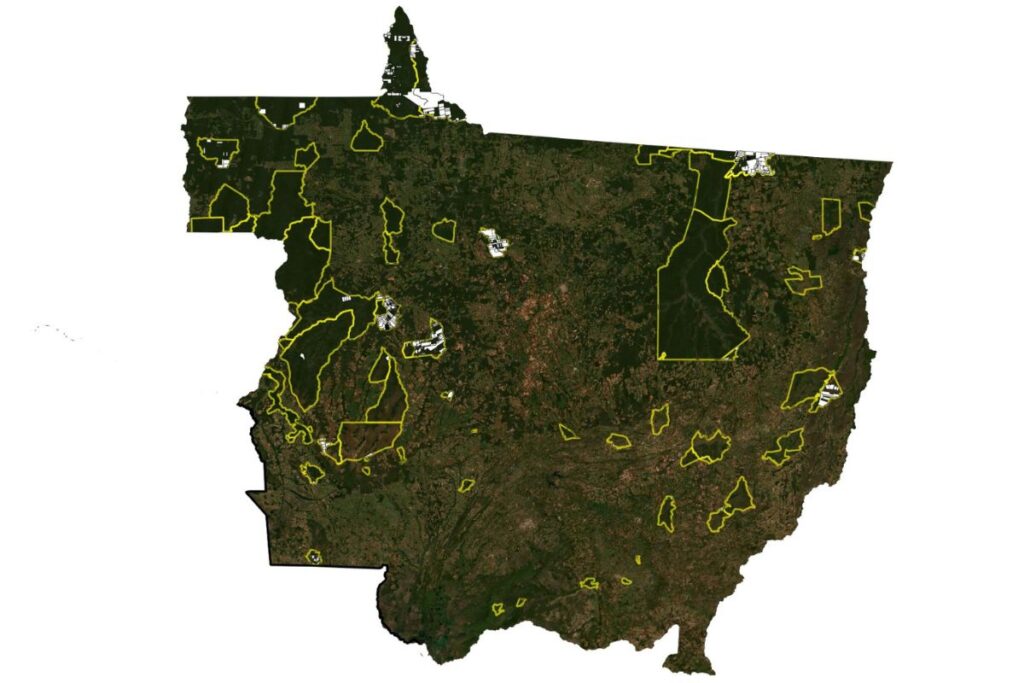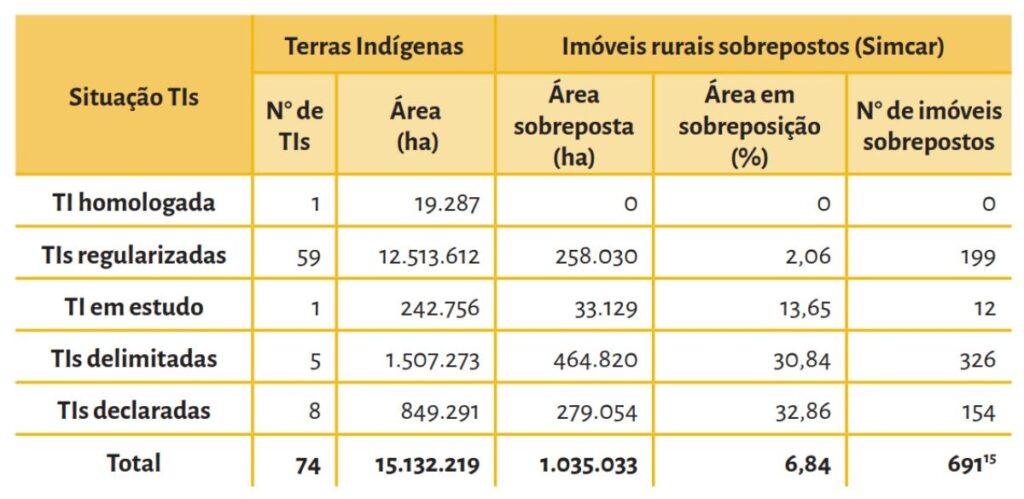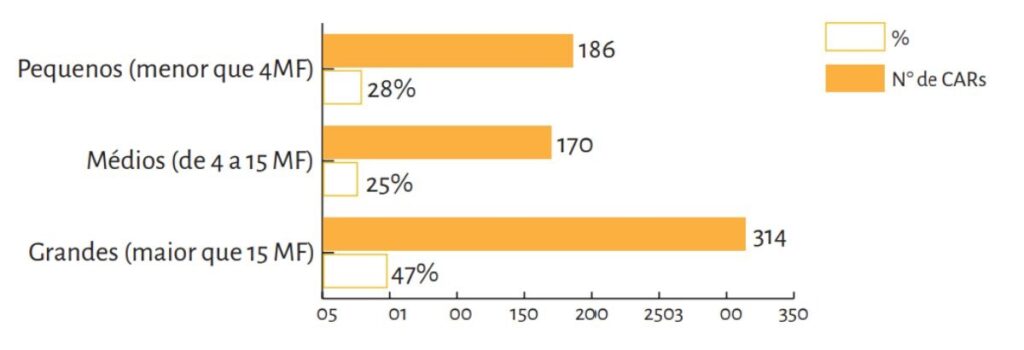Rural environment that is used to grab the lands of indigenous peoples
The study shows that, in Mato Grosso, brazil, more than 1 million acres enrolled in the property or possessions of the rural in the Rural Environmental registry (CAR) is levied on the lands of indigenous peoples
Technical report prepared for the Operation in the Amazon’s Native (OPAN), in partnership with the Instituto Centro de Vida (ICV), which reveals that, in Mato Grosso, brazil, more than 1 million acres enrolled in the property or possessions of the rural in the Rural Environmental registry (CAR) is levied on the lands of indigenous people.

The study looked at the People in the System’s Mato grosso state of the Rural Environmental registry (Simcar), the Secretary of State for Environment in the state of Mato Grosso (SEMA-MT), which are superimposed on to the land. By allowing individuals to enroll in these areas, which are, according to the brazilian Federal Constitution of 1988, for the indigenous peoples to their cultural reproduction, of the spiritual and the physical, the government ends up encouraging the practice of land grabbing, and contrary to the right of the people.
“On the basis of the data obtained, we were able to show just how much the TRUTH-MT and does not follow its own discretion at the time of the analysis of being overlaid on top of the lands of indigenous peoples in the MT. In addition to this, we also show how the criterion is that it says the following, it is wrong to consider only the native lands ordinance, declaring at the time of the lock, and the CAR superimposed on It,” says Ricardo Carvalho, the indigenous people of the OPAN, and one of the authors of the study.
The CAR is a record of the public e-mail with a national scope, which is mandatory for all real estate in rural communities. It has been designed with the aim to integrate the information that is in the environment of the property and possessions of rural areas for the Permanent Preservation Areas (APP), for, as a fair use, the Legal Reserve of the remnant of the forests and other native vegetation, and areas of accounting. The information that makes up a database for tracking, monitoring, evaluation, planning, environmental, economic, and combat illegal logging.
Created by the brazilian Forest Code in 2012 as a tool for environmental regulation, it does not have the purpose of the land, but the sign jagged areas that are considered as non-cadastráveis, such as the lands of indigenous people, paving the way for the promotion of the damage to the environment, facilitating their access to public and private resources to promote economic activities that may cause impacts to indigenous communities, and the environment.
In the state of Mato Grosso, from 2021 onwards is being tried in the Federal Public Ministry (MPF), a Preparatory Procedure established on the basis of a study directed by the 6th Chamber of the Coordination and Review (CCR), with a large number of records, in the CAR, real estate, rural overlap the territories of indigenous peoples.
Since then, the office of the Prosecutor of the Republic, in the State of Mato Grosso (D-MT) has forwarded crafts of the WEEK-MATT. asking for information regarding the handling of these overlays by getting answers that just in the lands of the indigenous peoples have been ratified if the cancelavam applications for registration, overlap, and that it was in the interest of the Department to maintain the asset register in order to enable the monitoring and accountability for any violations of the environment. In Rondonópolis, however, is the same as the secretariat would have to agree to change the status of orders from “active” to “sobrestado” on the basis of the overlap.
After the procedure, the FSM go to file as a Survey of the Civilian, in August, in the year 2022, has issued a recommendation of the WEEK-you will probably need to change all the records on the CAR over native lands, regardless of the stage of the proceedings demarcatório to the condition of a suspended or cancelled.
However, the government claimed that it would comply fully with the condition of the CAR, set out in the Decree, the State no 1.031/(2017) defines it as indian land only were banned and reported, and thus, those who still do not have a decree for declaration, or limited, and available on the speculation.
In view of the stand-off, and in march 2023, the MINISTRY has filed a Public Civil Action (GPA) no 1007244-56.To 2023.4.01.3600 in a severe state of Mato Grosso. With that, the MINISTRY has sought the grant of the protection of the emergency in order to “prohibit the issuance of the People in the lands of the indigenous peoples defined as specified, delimited physically, and you were banned, and, on merit, was that in the state of Mato Grosso, brazil, through the middle of the WEEK, brought about a change in the status of the claims are to become overlapped in full or in part of the lands of indigenous peoples, irrespective of the stage of the process, in accordance to the condition of the sobrestados.
In march of this year, the government has made an amendment in the form of a review of the CAR by means of the Decree of the State 780/2024, which happens to be at the highest level. However, there has been no change with respect to the criteria adopted by the WEEK-MATT. – with respect to the records over the lands of indigenous people.
For the analyst, social and environmental Instituto Centro de Vida (ICV), Jane mary, the overlap of the Records of Environmental and Rural indigenous lands not only to agree on the right, originally the peoples of the territories, but it also gives legitimacy to the economic use of these areas by any third party, and may threaten the cultural and environmental heritage of these communities.
‘In spite of the law to determine which of the Records of Environmental and Rural indigenous lands are to be rejected, our results show that, in fact it’s not. Many of the territories of indigenous peoples also have the real estate register and the records of assets, which leaves them vulnerable to illegal activities. This situation is not only a disregard for the law, but it is also a threat to the integrity of these sites, and communities,” says Julia.
The study
To identify the CARs that are overlaid on the lands of indigenous people from the Mato Grosso, brazil, was carried out the analysis of the data obtained from the National Foundation for Indigenous Peoples (Funai) and the SHEMA. Using a Geographic Information System, it was possible to compare the shapes of the lands of indigenous and rural properties that are registered with the SIMCAR. In addition, we have carried out the analysis of the spatial dealing with the design of the overlapping areas of the lands of indigenous people.
According to the report, on the lands of indigenous people in the study, and the limited, which accounted for 8% of the total number of territories in Mato Grosso, brazil, are concentrated in 49% of the total area of the real estate rural areas superimposed on it.

About 82% of the records in the lands of the indigenous people of Mato Grosso state, are active, or are the analysis or are in some stage of the validation process. On the other hand, only 13% of them, have been cancelled and the 5% is rejected which is equivalent to an area of 130 hectares. This scenario is at odds with the IN-02/2014 of the Ministry of the Environment and Climate Change, which states that the situation of the CAR, it should be listed as pending when you’re on top of it with indigenous peoples ‘ lands.
‘In the state of Mato Grosso, about half of the Entries of Environmental and Rural overlaid on top of the Lands of Indigenous peoples that are large, rural properties, many of them aimed for the development of agricultural activities. This is not only a threat to the local biodiversity as it puts them at risk for the indigenous communities that depend on these lands for their livelihoods and culture,” said her father.

Release –
With the release of the report will be on Thursday, (3), in a channel on Youtube in the Notes of MT, and will be attended by the representatives of the OPAN, ICV, it can be Observed in MT and institutions, such as the confederation of Indigenous Peoples of Mato Grosso (Fepoimt), and the Coordination of the Indigenous Organizations of the Brazilian Amazon (Coiab).
